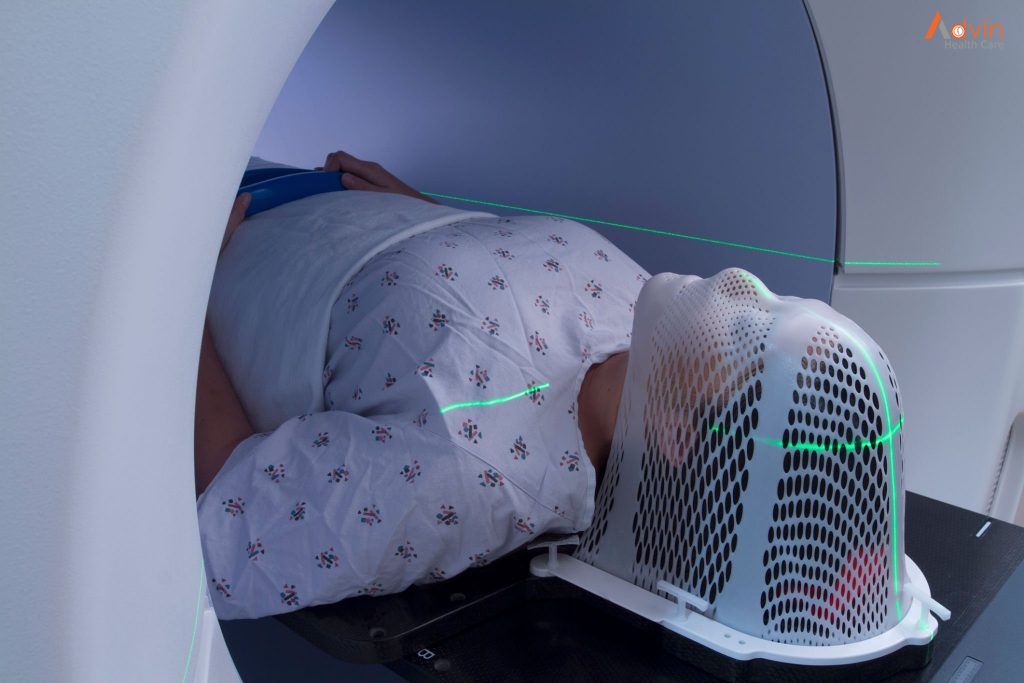Radiation therapy is a type of cancer treatment that uses beams of intense energy to kill cancer cells. Radiation therapy most often uses X-rays, but protons or other types of energy also can be used.
The term “radiation therapy” most often refers to external beam radiation therapy. During this type of radiation, the high-energy beams come from a machine outside of your body that aims the beams at a precise point on your body. During a different type of radiation treatment called brachytherapy (brak-e-THER-uh-pee), radiation is placed inside your body.
Radiation therapy damages cells by destroying the genetic material that controls how cells grow and divide. While both healthy and cancerous cells are damaged by radiation therapy, the goal of radiation therapy is to destroy as few normal, healthy cells as possible. Normal cells can often repair much of the damage caused by radiation.
Why it’s done
More than half of all people with cancer receive radiation therapy as part of their cancer treatment. Doctors use radiation therapy to treat just about every type of cancer. Radiation therapy is also useful in treating some noncancerous (benign) tumors.
How radiation therapy is used in people with cancer?
Your doctor may suggest radiation therapy as an option at different times during your cancer treatment and for different reasons, including:
- As the only (primary) treatment for cancer
- Before surgery, to shrink a cancerous tumor (neoadjuvant therapy)
- After surgery, to stop the growth of any remaining cancer cells (adjuvant therapy)
- In combination with other treatments, such as chemotherapy, to destroy cancer cells
- In advanced cancer to alleviate symptoms caused by the cancer
How you prepare
Before you undergo external beam radiation therapy, your health care team guides you through a planning process to ensure that radiation reaches the precise spot in your body where it’s needed. Planning typically includes:
- Radiation simulation. During simulation, your radiation therapy team works with you to find a comfortable position for you during treatment. It’s imperative that you lie still during treatment, so finding a comfortable position is vital. To do this, you’ll lie on the same type of table that’s used during radiation therapy. Cushions and restraints are used to position you in the right way and to help you hold still. Your radiation therapy team will mark the area of your body that will receive the radiation. Depending on your situation, you may receive temporary marking with a marker or you may receive small permanent tattoos.
- Planning scans. Your radiation therapy team will have you undergo computerized tomography (CT) scans to determine the area of your body to be treated.
After the planning process, your radiation therapy team decides what type of radiation and what dose you’ll receive based on your type and stage of cancer, your general health, and the goals for your treatment.
The precise dose and focus of radiation beams used in your treatment is carefully planned to maximize the radiation to your cancer cells and minimize the harm to surrounding healthy tissue.
What you can expect

External beam radiation therapy is usually conducted using a linear accelerator — a machine that directs high-energy beams of radiation into your body.
As you lie on a table, the linear accelerator moves around you to deliver radiation from several angles. The linear accelerator can be adjusted for your particular situation so that it delivers the precise dose of radiation your doctor has ordered.
You typically receive external beam radiation on an outpatient basis five days a week over a certain period of time. In most instances, treatments are usually spread out over several weeks to allow your healthy cells to recover in between radiation therapy sessions.
Expect each treatment session to last approximately 10 to 30 minutes. In some cases, a single treatment may be used to help relieve pain or other symptoms associated with more-advanced cancers.
During a treatment session, you’ll lie down in the position determined during your radiation simulation session. You might be positioned with molds to hold you in place.
The linear accelerator machine may rotate around your body to reach the target from different directions. The machine makes a buzzing sound.
You’ll lie still and breathe normally during the treatment, which takes only a few minutes. For some patients with lung or breast cancer, you might be asked to hold your breath while the machine delivers the treatment.
Your radiation therapy team stays nearby in a room with video and audio connections so that you can talk to each other. You should speak up if you feel uncomfortable, but you shouldn’t feel any pain during your radiation therapy session.
Results
If you’re receiving radiation to a tumor, your doctor may have you undergo periodic scans after your treatment to see how your cancer has responded to radiation therapy.
In some cases, your cancer may respond to treatment right away. In other cases, it may take weeks or months for your cancer to respond. Some people aren’t helped by radiation therapy.

